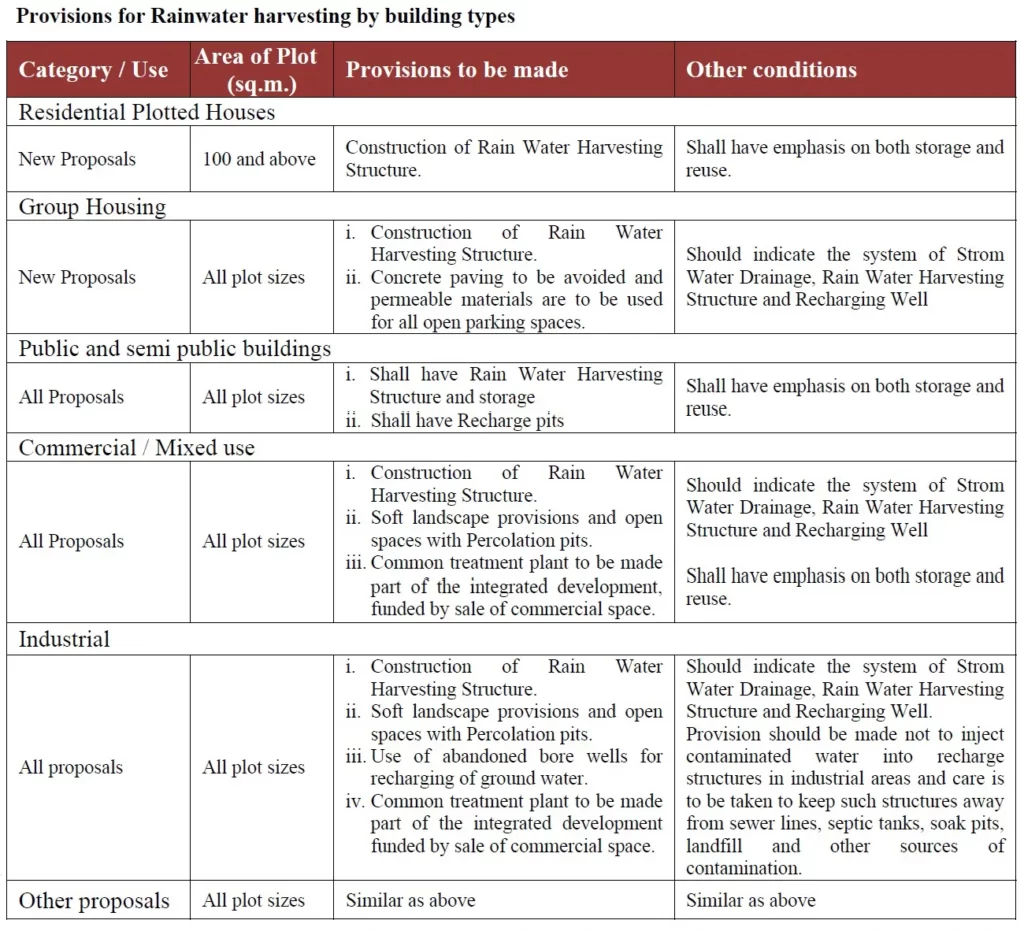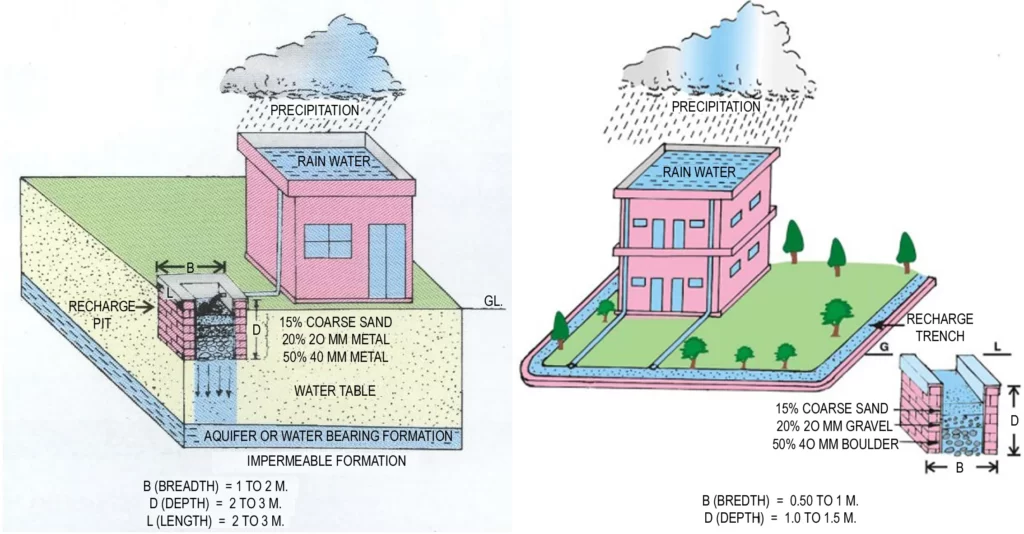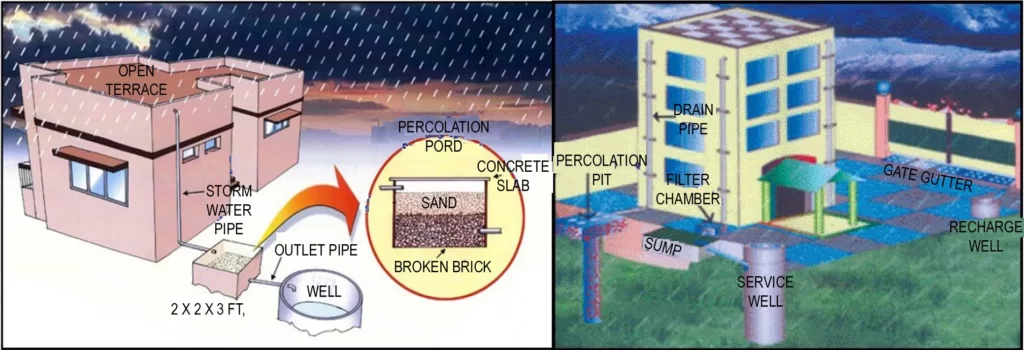If you want to know about the water supply requirements for building or water supply system in tall building or principles of water supply, please click the link.
Rainwater harvesting is the process of collecting and storing rainwater for future use. A rainwater harvesting system can be as simple as a barrel placed under a downspout to collect rainwater from a roof, or as complex as a multi-stage filtration and storage system for potable water.
- The harvesting of rainwater simply involves the collection of water from surfaces on which rain falls, and subsequently storing this water for use.
- The rainwater collected can be stored for direct use or can be recharged into the underground aquifers.
- In scientific terms water harvesting (broadly) refers to collection and storage of rainwater from the rooftops.
- This also restricts evaporation and seepage into building foundations.
- All buildings having a plot size of 100 sq.m. or more, while submitting the building plans for sanction, shall mandatorily include the complete proposal of rainwater harvesting.
- A rainwater harvesting system consists of…....
- Roof catchment
- Gutters
- Down pipes
- Rain water/ Storm water drains
- Filter Chamber
- Storage Tanks/ Pits/ Sumps.
- Ground Water recharge structures like pit, trench, tube well or combination of above structure.
Rainwater Harvesting is a way to capture the rain runoff, store that water above ground or charge the underground aquifers and use it later.
- This happens naturally in open rural areas. But in congested, over-paved metropolitan cities, there is a need to devise methods to capture the rain water.
- The rainwater that is incident on the surface/ roof top is guided to bore wells or pits or new/old/ abandoned wells through small diameter pipes to recharge the underground water which can be used later whenever required.
- Rainwater can be harvested to the extent of 55,000 liters per 100sq. meters area per year from rooftops.
1) Rainwater harvesting techniques
There are two main techniques of rain water harvestings.
- Storage of rainwater on surface for future use.
- Recharge to ground water.
Technical Terms
- The storage of rain water on surface is a traditional technique and the structures used were underground tanks, ponds, check dams, weirs etc. Recharge to ground water is a new concept of rain water harvesting and the structures generally used are:-
- Pits: Recharge pits are constructed for recharging the shallow aquifer. These are constructed 1 to 2m, wide and to 3m. deep which are back filled with boulders, gravels, coarse sand.
- Trenches: These are constructed when the permeable stream is available at shallow depth. Trench may be 0.5 to 1m. wide, 1 to 1.5m deep and 10 to 20m long depending up availability of water. These are back filled with filler materials.
- Dug wells: Existing dug wells may be utilized as recharge structure and water should pass through filter media before putting into dug well.
- Hand pumps: The existing hand pumps may be used for recharging the shallow/deep aquifers, if the availability of water is limited. Water should pass through filter media before diverting it into hand pumps.
- Recharge wells: Recharge wells of 100 to 300 mm. diameter are generally constructed for recharging the deeper aquifers and water is passed through filter media to avoid choking of recharge wells.
- Recharge Shafts: For recharging the shallow aquifer which are located below clayey surface, recharge shafts of 0.5 to 3 m. diameter and 10 to 15 m. deep are constructed and back filled with boulders, gravels & coarse sand.
- Lateral shafts with bore wells: For recharging the upper as well as deeper aquifers lateral shafts of 1.5 to 2 m. wide & 10 to 30 m. long depending upon availability of water with one or two bore wells are constructed. The lateral shafts are back filled with boulders, gravels & coarse sand.
- Spreading techniques: When permeable strata start from top then this technique is used. Spread the water in streams/Nalas by making check dams, nala bunds, cement plugs, gabion structures or a percolation pond may be constructed.
2) Harvesting provisions in various Building categories
- All buildings in a city contribute to the rainwater runoff during the monsoon and hence such runoff can be harvested for water reuse/recharge.
- The indicative provisions of rainwater harvesting in various buildings types are:

Note – The number of recharge bores to be provided in different plot sizes shall be accordance to calculation.
3) Rainwater Harvesting Provisions for Open spaces in cities
- The open spaces/recreational land use generally constitute regional parks, district parks, playground and stadium, sports complex, monument zones, public parking, Plaza and other public open space. This may be as high as 30% to 50% of the city’s geographic area. All such public open spaces above the size of 500 sq.m. shall have arrangements for complete utilization and capture of storm water with scientific rainwater harvesting arrangements.
- Following ideas may also be included:
- Well cum Channel cum Percolation pits.
- Use of abandoned bore wells for recharging of ground water
- Artificial or natural Storage of storm water runoff from larger sites.
4) Ground Water Recharge
- Recharging of ground water should be made mandatory not only for residential buildings but for all types of buildings, including Group Housing Societies having a plot area more than 500 sq.m. and above.
- The Ground Water Recharge should also be mandatory for open spaces like parks, parking, plazas and playgrounds. The harvesting and recharge structures could be constructed by the Authority with the involvement of community based organizations like Resident Welfare Associations.
5) Enforcement and Monitoring
- The Authority shall constitute a Rainwater Harvesting Cell which will be responsible for enforcement and monitoring of the provisions of Rainwater Harvesting. The cell shall employ qualified persons who are well versed with the interpretation of Building Bye Laws and responsible for enforcement as well as monitoring the functioning of the Rainwater Harvesting System.
- The Authority shall include inspection of Rainwater Harvesting Structures before issuing Completion Certificates or NOCs for service connections to the property.
- Set an example in the city by ensuring that Rainwater is harvested in the properties /assets owned by them including public buildings, markets, community centers, parking spaces, roads and parks etc.
- The Authority shall also establish a mechanism to monitor 100% of RWH provisions in all the buildings above 1000 sq.m. with annual physical verification, while buildings less than 1000 sq.m. can be monitored on the basis of 10% random survey by competent authority.
- With regard to open public spaces viz., Parks, playgrounds etc. the implementation of provision rainwater harvesting may be done with the help of Residents Welfare Associations, Community Building Organization and Non-Governmental Organizations.
- The Authority shall ensure earmarking budgetary provision for the creation and maintenance of rainwater harvesting structures in public spaces owned and maintained by them, like parking spaces, parks, plazas etc.
- The practice of incentives and penalties to promote rain water harvesting shall be formulated by the local authority based on best practices. Authority shall design its own incentive and penalty systems, considering the water level and scarcity.
ILLUSTRATIONS OF COMMON HARVESTING TECHNIQUES
- Rainwater harvesting and groundwater recharge for individual plotted house (by percolation pits and well-cum-channel)

- Rainwater harvesting and groundwater recharge for individual plotted house and multistoreyed residential building (by storage sump and percolation pits)

- Rainwater harvesting for parks/open spaces

- Rainwater collection (through downpipes and sieves)

- Rainwater collection and Groundwater recharge (through abandoned wells and Hand pumps)

Rainwater harvesting systems can provide a number of benefits, including reducing demand on municipal water supplies, lowering water bills, and helping to manage stormwater runoff. However, it is important to ensure that the system is designed and installed properly to avoid potential health and safety risks.